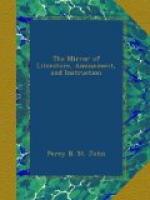THE MIRROR OF LITERATURE, AMUSEMENT, AND INSTRUCTION.
Vol. XIX. No. 554.] Saturday, June 30, 1832. [Price 2d.
* * * * *
[Illustration: Curious chimney-piece.]
We select this Engraving as an illustration of the elaborate sculptural decoration employed in domestic architecture about three centuries since; but more particularly as a specimen of the embellishment of the ecclesiastical residences of that period. It represents a chimney-piece erected in the Bishop’s palace at Exeter, by Peter Courtenay, who was consecrated Bishop of Exeter, A.D. 1477, and translated to Winchester, A.D. 1486. He had formerly been master of St. Antony’s Hospital, in London.
The bishop was third son of Sir Philip Courtenay of Powderham, knight, (fifth son of Hugh Courtenay, second Earl of Devonshire), who died 1463.
He was educated at Exeter College, Oxford; made archdeacon of Exeter 1453; dean of the same church, 1477.
He died 1491, and was probably buried in the chancel at Powderham, where is an effigy of a bishop inlaid in brass. He built the north tower of Exeter cathedral, and placed in it a great bell, called after him Peter’s bell, with a clock and dial: he built also the tower and good part of the church at Honiton (which before was only a chapel, now the chancel). In the windows of the tower are the arms of his parents, now lost; but his paternal arms are on the pillars of the chancel.[1]
The heraldic embellishments of the chimney-piece are as follow:—
“The arms of Courtenay impaled by those of the see of Exeter are in the centre compartment. In that on the left hand is the former coat single, supported by two swans collared and chained. Motto Arma Petri Exon epi. And on the right hand it impales Hungerford, supported by two boars with the Courtenay label round their necks. Motto Arma Patris et Matris.
“Above the centre compartment is the mitre, with the arms of the see, and a label inscribed Colompne ecclesie veritatis p’conie;[2] and here the T is thrice repeated.
“The moulding of the arch is charged with the portcullis and foliage alternately; and on the point are the royal arms in a garter, and supported by two greyhounds.
“The T with the bell appendant occurs on the sides of the centre coat; also the T single and labels, and over the top of the chimney the T and P C for Peter Courtenay.
“The three Sickles and the Sheaf in the angles of the three compartments are the badges of the barons of Hungerford.”
Further explanation is necessary, as well as interesting for its connexion with two popular origins—St. Antony’s fire, and St. Antony, or “Tantony’s Pig.”
“The monks of the order of St. Antony wore a black habit with the letter T of a blue colour on the breast. This may sufficiently account for the appearance of that figure among the ornaments of Bishop Courtenay’s arms. The following extract from Stow’s Survey of London may serve to explain the appendant Bell.




